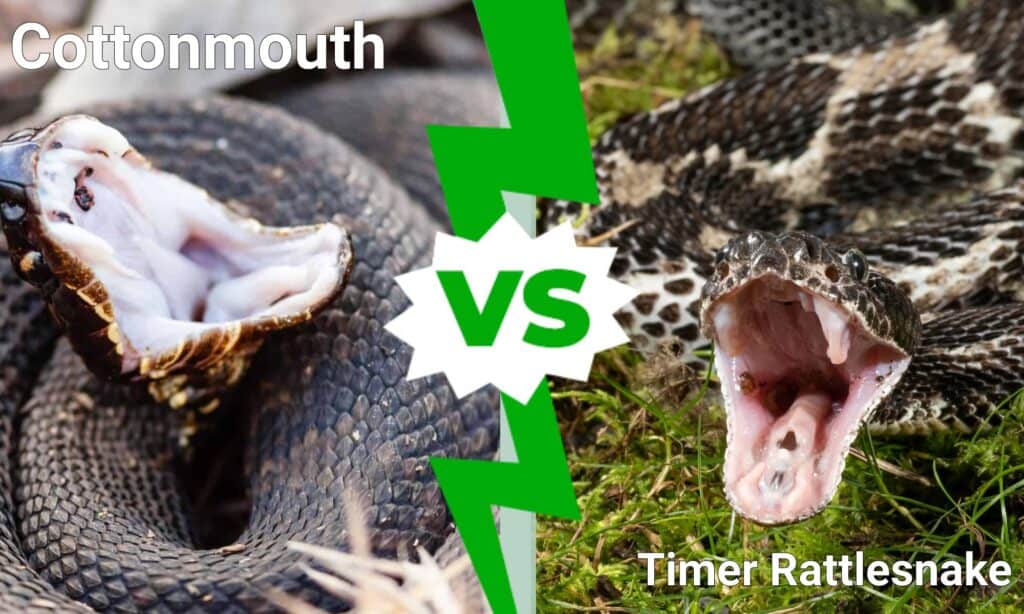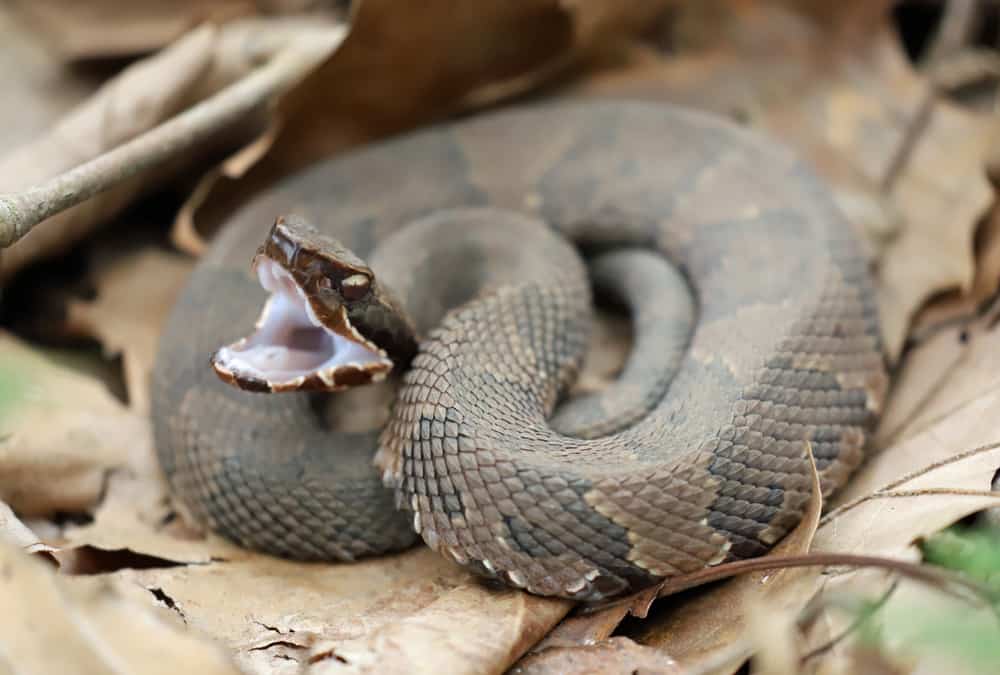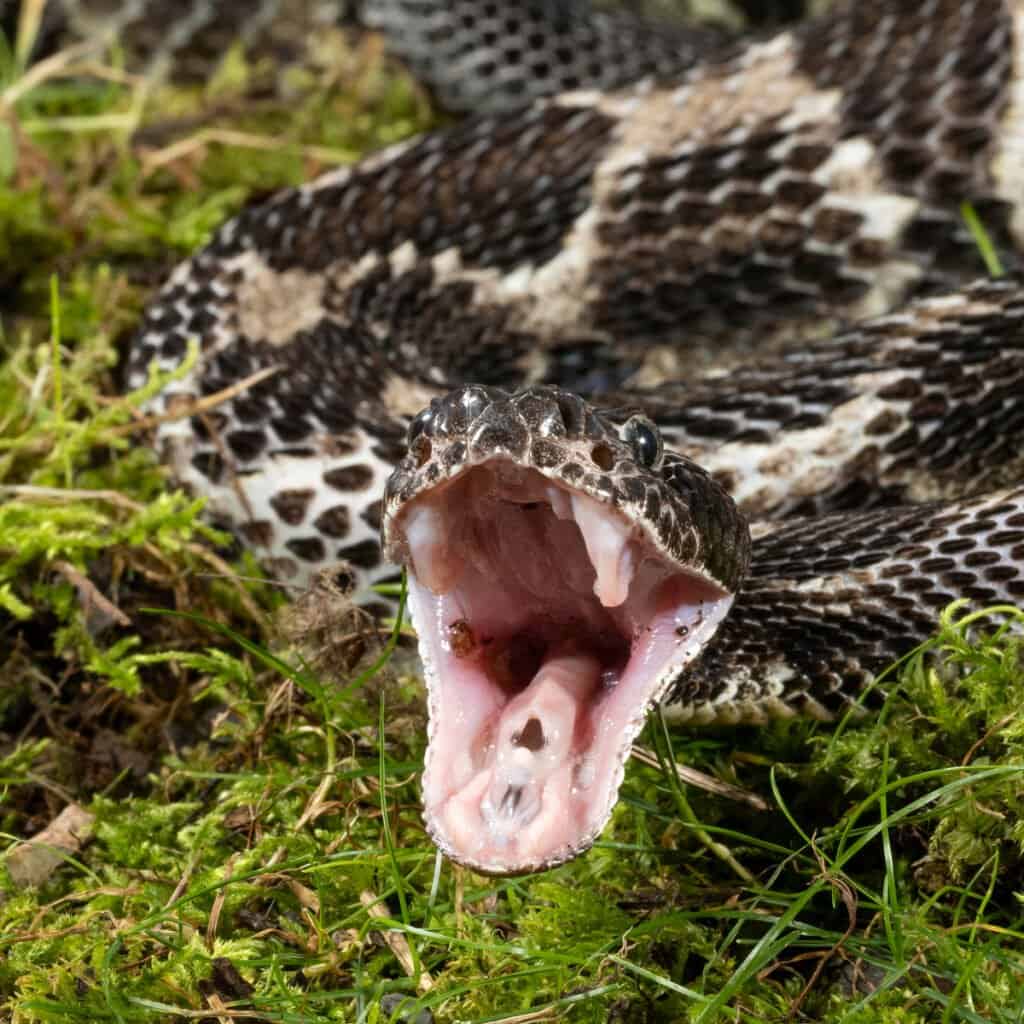Snakes live all over the world, they can be found on every continent except Antarctica. In the eastern United States, two of the most common species you might encounter are the cottonmouth and the timber rattlesnake. The cottonmouth (Agkistrodon piscivorus) is also known as the water moccasin, while the timber rattlesnake (Crotalus horridus) is often called a canebrake rattlesnake. Both species are venomous, and each can deliver a nasty bite if provoked.
Here, we’ll take a deep dive into the exact differences between cottonmouths and timber rattlesnakes. First, we’ll learn about how similar, and dissimilar, they look to one another. Then, we’ll take a look at the preferred habitat of each. After that we’ll go over each species’ behavior and diet, and why they’re similar and different. Finally, we’ll take a look at the type of venom each species has, and just how dangerous they are.
The Key Differences Between Cottonmouths and Timber Rattlesnakes

The primary difference between timber rattlesnakes and cottonmouths is that timber rattlesnakes tend to be found more in forested areas while cottonmouths prefer aquatic habitats like swamps, streams, and marshes. When it comes to appearance, the cottonmouth has a very white mouth while timber rattlesnakes have a more traditional flesh tone. Also, timber rattlesnakes have a rattle on their tail while cottonmouths don’t!
Let’s dive into the major differences between these two snakes in more detail.
Cottonmouth vs Timber Rattlesnake: Appearance
Cottonmouth snakes grow to between two and four feet in length as adults, while timber rattlesnakes can get a little bigger at up to five feet. Both species begin life as 10-12 inch long snakelings. For both timber rattlers and water moccasins, adults are darker than juveniles. Additionally, both species are heavy-bodied, with large, heavy heads. Cottonmouths have one more unique feature — an all white mouth, hence their name.

Timber rattlesnakes have a distinct, banded pattern of V or M-shaped bands.
©Frode Jacobsen/Shutterstock.com
For coloring, timber rattlesnakes have a more distinct pattern than cottonmouths. Cottonmouths range in color from yellow with brown bands to completely brown or completely black. Often, adults grow darker as they age. Timber rattlesnakes have a base color of light gray with distinct dark gray chevron patterned rings along their body.
Cottonmouth vs Timber Rattlesnake: Habitat
Both the cottonmouth and timber rattlesnake inhabit the southeastern United States, as far west as Texas, and as far east as the east coast. The most striking difference in population between the two is in the state of Florida, which is home to cottonmouths, but not to timber rattlesnakes. Further, timber rattlesnakes occur much farther north than cottonmouths, which live no farther north than southern Virginia. Timber rattlesnakes, on the other hand, can be found as far north as Vermont.
Locally, cottonmouth snakes are much more likely to be found in or around water. They prefer environments like swamps, rivers, lakes, floodplains, and permanent sources of freshwater. Timber rattlesnakes live predominantly in cane thickets, swamps, mountainous areas, forests, and floodplains. Although they are excellent swimmers, timber rattlesnakes are not semi-aquatic.
Cottonmouth vs Timber Rattlesnake: Behavior
They may be different species, but both water moccasins and timber rattlers produce snakelings only every 2-3 years. Female timber rattlesnakes aren’t considered sexually mature until they’re at least five years old. Male cottonmouths actually fight one another for breeding rights. Both species give birth to live young in late summer or early fall.

Cottonmouths do not have rattle, but they do have a unique white mouth
©KF2017/Shutterstock.com
When threatened, the timber rattlesnake coils into a defensive position and rattles its rattle at the would-be attacker. The cottonmouth, lacking a rattle, coils into the same defensive position and opens its mouth. The insides of their mouths are bright white—they seem to function in much the same way that a rattlesnake’s rattle functions. That is, they let potential attackers know that they’re venomous and will bite if necessary. Neither species is particularly aggressive, but cottonmouths will stand their ground if threatened, rather than flee.
Cottonmouth vs Timber Rattlesnake: Diet
Cottonmouths and timber rattlesnakes may look similar, but they have vastly different diets. This is in large part due to their different lifestyles; cottonmouths are semi-aquatic, while timber rattlesnakes are entirely terrestrial.
Timber rattlesnakes have a pretty restricted diet that consists mostly of small rodents for young snakes, and grows to include squirrels and rabbits for adult snakes. Cottonmouths have a much wider diet that includes everything from fish to baby alligators. An adult cottonmouth hunts both on the land and in the water; they eat small mammals, amphibians, reptiles, smaller snakes, turtles, birds, fish, and baby alligators.
Because they live in many of the same environments, it’s not impossible for cottonmouths to eat timber rattlesnakes, and vice versa. Both are opportunistic hunters who frequently prey on creatures smaller than themselves. This means that, if a baby snake of another species—or even the same species—wanders across a hungry adult’s path, it’s likely to become lunch.
Cottonmouth vs Timber Rattlesnake: Venom
Both timber rattlesnakes and cottonmouths are members of the pit viper family; they each carry a potent hemotoxic venom that can cause both tissue necrosis (death) and bodily death. Since each species preys specifically on small creatures like rabbits and fish, they most often reserve their venom for food-sized prey. This means that, when either species bites a human, they often deliver a ‘dry’ bite, free of venom.

Both timber rattlesnakes and cottonmouths have large, retractable fangs
©Joe McDonald/Shutterstock.com
Timber rattlers and water moccasins carry the same type of venom, it’s meant to rapidly kill prey, and begin the process of digestion. This means that the tissue around the bite actually starts to die (necrotize) immediately after venom delivery. In the body, the venom causes paralysis and organ failure, leaving a nice, freshly dead morsel for the snake to swallow whole.
Cottonmouth or Timber Rattlesnake: Which is More Dangerous?
A bite from either a cottonmouth or a timber rattlesnake is enough to warrant a trip to the hospital. But, out of the two, the timber rattlesnake’s bite is much more serious. While both species use hemotoxic venom, the timber rattlesnake’s venom is more likely to cause serious complications, or even death, in humans.
If you sustain a bite, the important thing to do is get away from the snake. Do not attempt to kill or capture it. Keep the bite below heart level, and try to keep the bite victim’s heart rate low. Do not ice the bite, attempt to suck out the venom, or make any incisions over the puncture wounds. Instead, get the victim to the nearest hospital, where medical professionals can administer intravenous fluids and antivenom.
The photo featured at the top of this post is © Joe McDonald/Shutterstock.com
Discover the "Monster" Snake 5X Bigger than an Anaconda
Every day A-Z Animals sends out some of the most incredible facts in the world from our free newsletter. Want to discover the 10 most beautiful snakes in the world, a "snake island" where you're never more than 3 feet from danger, or a "monster" snake 5X larger than an anaconda? Then sign up right now and you'll start receiving our daily newsletter absolutely free.
Thank you for reading! Have some feedback for us? Contact the AZ Animals editorial team.






